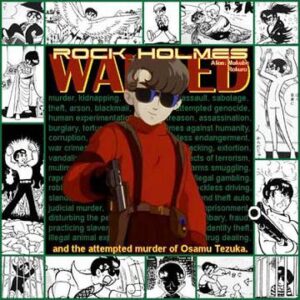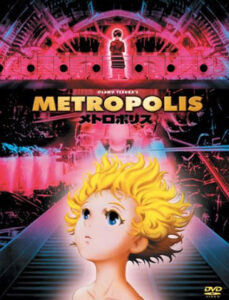Rock Holmes: Transformation – Introduction
A study of reincarnation in Osamu Tezuka’s Star System
by Ada Palmer
Rock Holmes: Transformation – Part 1: INTRODUCTION
Rock Holmes: Transformation – Part 1: CHILDHOOD
Rock Holmes: Transformation – Part 2: TRANSFORMATION
Rock Holmes: Transformation – Part 3: RESOLUTION
Rock Holmes: Transformation – Part 4: AFTERLIFE

Rock Holmes: Wanted
INTRODUCTION: ROCK’S MANY INCARNATIONS
Section 1: SOURCES
This essay avoids complete plot summaries whenever possible, but does reveal plot points when necessary, and provides extensive summaries of series not available in English. Prior familiarity with the works treated is not necessary, but if you prefer to approach stories unspoiled, then before reading this essay you will want to read or watch as many as you can of the following: mangas (available in English) Nextworld, Metropolis, Buddha, Phoenix, Black Jack, Astro Boy, (in other western languages): Vampires, Rainbow Parakeet), more Black Jack, MW, Prince Norman (Asian languages only) Detective Boy Rock Holmes, Adventures of Rock, Road to Utopian Lurue, Alabaster, Say Hello to Bookilla, Black Jack NEO; animation (in English) Metropolis movie, episodes 34 and 35 of the 2003 Astro Boy TV series (not in English) Fumoon, Princess Knight TV series, Marine Express, Jetter Mars, second Black Jack movie, “Two Dark Doctors,”, Black Jack TV series. Rock’s roles in the the Astro Boy: OMEGA FACTOR game for the GBA will also be treated.
Frequently as you read this essay you will want to consult our Chronological List of Rock’s Appearances which contains all the series indexed on the official Tezuka World web page, plus many more recent and obscure appearances omitted by the site.

Metropolis Movie
Section 2: FIRST ENCOUNTER
Most Americans have their first exposure to Rock in the Metropolis movie, encountering him as a stark and absolute soldier, with a gun always in his hand and a sense of loyalty and justice so absolute as to verge on madness. After this, it is unsettling to learn that Rock did not appear in the original Metropolis manga published in 1949, and one is left wondering who this character is and what the story might have been like without him. But this experience is completely different from that of the long-time Tezuka reader, who, before the film’s release, had already seen Rock in dozens of different works created during Tezuka’s lifetime, and who also knew the original Rock-free Metropolis manga as one of the groundbreaking works of Japanese science-fiction. To picture the impact of such a Tezuka reader seeing the Metropolis movie poster for the first time, imagine an American moviegoer spotting a poster for a new Batman movie, only to find Lex Luthor lounging confidently in the background; it is the right genre, even the right universe, but still wrong.
Tezuka’s reuse of characters in multiple stories is one of his signatures, referred to as his ‘Star System’.
Tezuka’s reuse of characters in multiple stories is one of his signatures, referred to as his ‘Star System,’ in which the characters are treated as actors who appear over and over in multiple roles, developing over the course of their ‘careers.’ Tezuka even went so far as to draw up a list of the fictitious salary each of his ‘actors’ demanded per appearance. Thus we find the detective Shunsaku Ban as Astro’s school teacher, Sharaku the Three-Eyed-One as Assaji in Buddha, and just about everyone as a patient in Black Jack. But Tezuka’s Star System is more than simple re-use of characters, since Tezuka uses repeat appearances to explore and expand on the themes of earlier stories. He may, for example, present a robot character as a human (Astro in Rainbow Parakeet), #3 “A Doll’s House”), reversing the roles of a cop and robber (Lamp and Shunsaku Ban in Black Jack #218, “Pickpocket from the Yamanoto Line”), or giving salvation in one life to a young man who had pleaded for it when dying in another (Yamanobe in Phoenix chapter 2, “Future” and Black Jack #127, “Devotion to Medicine”).
The re-examination of characters in multiple roles is made even stronger by a focus on the theme of reincarnation which appears throughout Tezuka’s work. This treated most directly in the Phoenix manga, in which the same individual will explicitly appear in multiple reincarnations over the course of human history, and the actions and sins of one life explain the events and sufferings of another. Buddha too, written as a companion piece to Phoenix, treats reincarnation directly, in this case examining how characters whose lives are usually locked into recurring patterns are set on different path this time as they are touched by the presence of the Buddha. In many cases, the actions and nature of a character in one Tezuka series are only made clear by events in another, as in the case of Kassapa, the fire priest who gives up science to follow Buddha, who would be a comparatively forgettable figure if not played by Saruta, the scientist devoted to the rational exploration of the nature of life in Phoenix, who is also Black Jack’s mentor, Dr. Honma.
A combined multi-series analysis is particularly appropriate in Rock’s case. Most of Tezuka’s characters are solidly type-cast, villains always playing villains and heroes always playing heroes. Rock, on the other hand, ran the full gamut of roles, beginning as a boy hero and developing into one of the most reviled villain in the Tezuka corpus. When Rock’s many appearances are taken as a whole, his development from hero to villain can be used as a marker to trace the darkening of key philosophical themes in all of Tezuka’s works, and Rock’s insertion into the Metropolis movie falls into place as another exploration of the same issues he faced in his sixty previous incarnations.



Leave a Reply